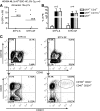Serum- and stromal cell-free hypoxic generation of embryonic stem cell-derived hematopoietic cells in vitro, capable of multilineage repopulation of immunocompetent mice
- PMID: 23197864
- PMCID: PMC3659726
- DOI: 10.5966/sctm.2012-0020
Serum- and stromal cell-free hypoxic generation of embryonic stem cell-derived hematopoietic cells in vitro, capable of multilineage repopulation of immunocompetent mice
Abstract
Induced pluripotent stem cells (iPSCs) may become a promising source for the generation of patient-specific hematopoietic stem cells (HSCs) in vitro. A crucial prerequisite will be the availability of reliable protocols for the directed and efficient differentiation toward HSCs. So far, the most robust strategy for generating HSCs from pluripotent cells in vitro has been established in the mouse model involving ectopic expression of the human transcription factor HOXB4. However, most differentiation protocols include coculture on a xenogenic stroma cell line and the use of animal serum. Involvement of any of both would pose a major barrier to the translation of those protocols to human autologous iPSCs intended for clinical use. Therefore, we asked whether long-term repopulating HSCs can, in principle, be generated from embryonic stem cells without stroma cells or serum. Here, we showed that long-term multilineage engraftment could be accomplished in immunocompetent mice when HSCs were generated in serum-free medium without stroma cell support and when hypoxic conditions were used. Under those conditions, HOXB4(+) embryonic stem cell-derived hematopoietic stem and progenitor cells were immunophenotypically similar to definitive bone marrow resident E-SLAM(+) (CD150(+)CD48(-)CD45(+)CD201(+)) HSCs. Thus, our findings may ease the development of definitive, adult-type HSCs from pluripotent stem cells, entirely in vitro.
Figures






Similar articles
-
A novel serum-free monolayer culture for orderly hematopoietic differentiation of human pluripotent cells via mesodermal progenitors.PLoS One. 2011;6(7):e22261. doi: 10.1371/journal.pone.0022261. Epub 2011 Jul 27. PLoS One. 2011. PMID: 21818303 Free PMC article.
-
The OP9-DL1 system: generation of T-lymphocytes from embryonic or hematopoietic stem cells in vitro.Cold Spring Harb Protoc. 2009 Feb;2009(2):pdb.prot5156. doi: 10.1101/pdb.prot5156. Cold Spring Harb Protoc. 2009. PMID: 20147086 No abstract available.
-
Mouse Bone Marrow VSELs Exhibit Differentiation into Three Embryonic Germ Lineages and Germ & Hematopoietic Cells in Culture.Stem Cell Rev Rep. 2017 Apr;13(2):202-216. doi: 10.1007/s12015-016-9714-0. Stem Cell Rev Rep. 2017. PMID: 28070859
-
The hemogenic endothelium: a critical source for the generation of PSC-derived hematopoietic stem and progenitor cells.Cell Mol Life Sci. 2021 May;78(9):4143-4160. doi: 10.1007/s00018-021-03777-y. Epub 2021 Feb 9. Cell Mol Life Sci. 2021. PMID: 33559689 Free PMC article. Review.
-
Hematopoietic cell differentiation from embryonic and induced pluripotent stem cells.Stem Cell Res Ther. 2013 Jun 18;4(3):71. doi: 10.1186/scrt222. Stem Cell Res Ther. 2013. PMID: 23796405 Free PMC article. Review.
Cited by
-
HOXB4 Promotes Hemogenic Endothelium Formation without Perturbing Endothelial Cell Development.Stem Cell Reports. 2018 Mar 13;10(3):875-889. doi: 10.1016/j.stemcr.2018.01.009. Epub 2018 Feb 15. Stem Cell Reports. 2018. PMID: 29456178 Free PMC article.
-
HOXB4 Increases Runx1 Expression to Promote the de novo Formation of Multipotent Hematopoietic Cells.Transfus Med Hemother. 2017 Jun;44(3):128-134. doi: 10.1159/000477130. Epub 2017 May 19. Transfus Med Hemother. 2017. PMID: 28626363 Free PMC article.
-
The pluripotency factor NANOG controls primitive hematopoiesis and directly regulates Tal1.EMBO J. 2019 Apr 1;38(7):e99122. doi: 10.15252/embj.201899122. Epub 2019 Feb 27. EMBO J. 2019. PMID: 30814124 Free PMC article.
-
In vivo repopulating activity emerges at the onset of hematopoietic specification during embryonic stem cell differentiation.Stem Cell Reports. 2015 Mar 10;4(3):431-44. doi: 10.1016/j.stemcr.2015.01.003. Epub 2015 Feb 5. Stem Cell Reports. 2015. PMID: 25660408 Free PMC article.
-
Lost in translation: pluripotent stem cell-derived hematopoiesis.EMBO Mol Med. 2015 Nov;7(11):1388-402. doi: 10.15252/emmm.201505301. EMBO Mol Med. 2015. PMID: 26174486 Free PMC article. Review.
References
-
- Hanna J, Wernig M, Markoulaki S, et al. Treatment of sickle cell anemia mouse model with iPS cells generated from autologous skin. Science. 2007;318:1920–1923. - PubMed
-
- Rideout WM, 3rd, Hochedlinger K, Kyba M, et al. Correction of a genetic defect by nuclear transplantation and combined cell and gene therapy. Cell. 2002;109:17–27. - PubMed
-
- Medvinsky A, Rybtsov S, Taoudi S. Embryonic origin of the adult hematopoietic system: Advances and questions. Development. 2011;138:1017–1031. - PubMed
-
- Medvinsky A, Dziercak E. Definitive hematopoiesis is autonomously initiated by the AGM region. Cell. 1996;86:897–906. - PubMed
Publication types
MeSH terms
Substances
Grants and funding
LinkOut - more resources
Full Text Sources
Other Literature Sources
Medical
Research Materials
Miscellaneous

